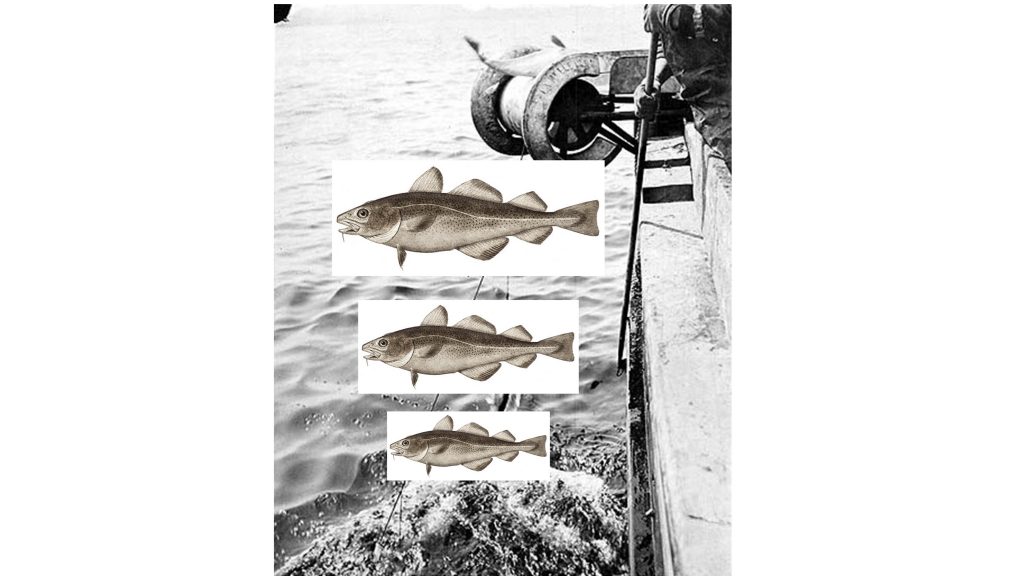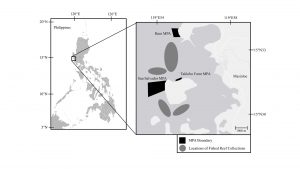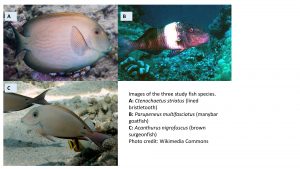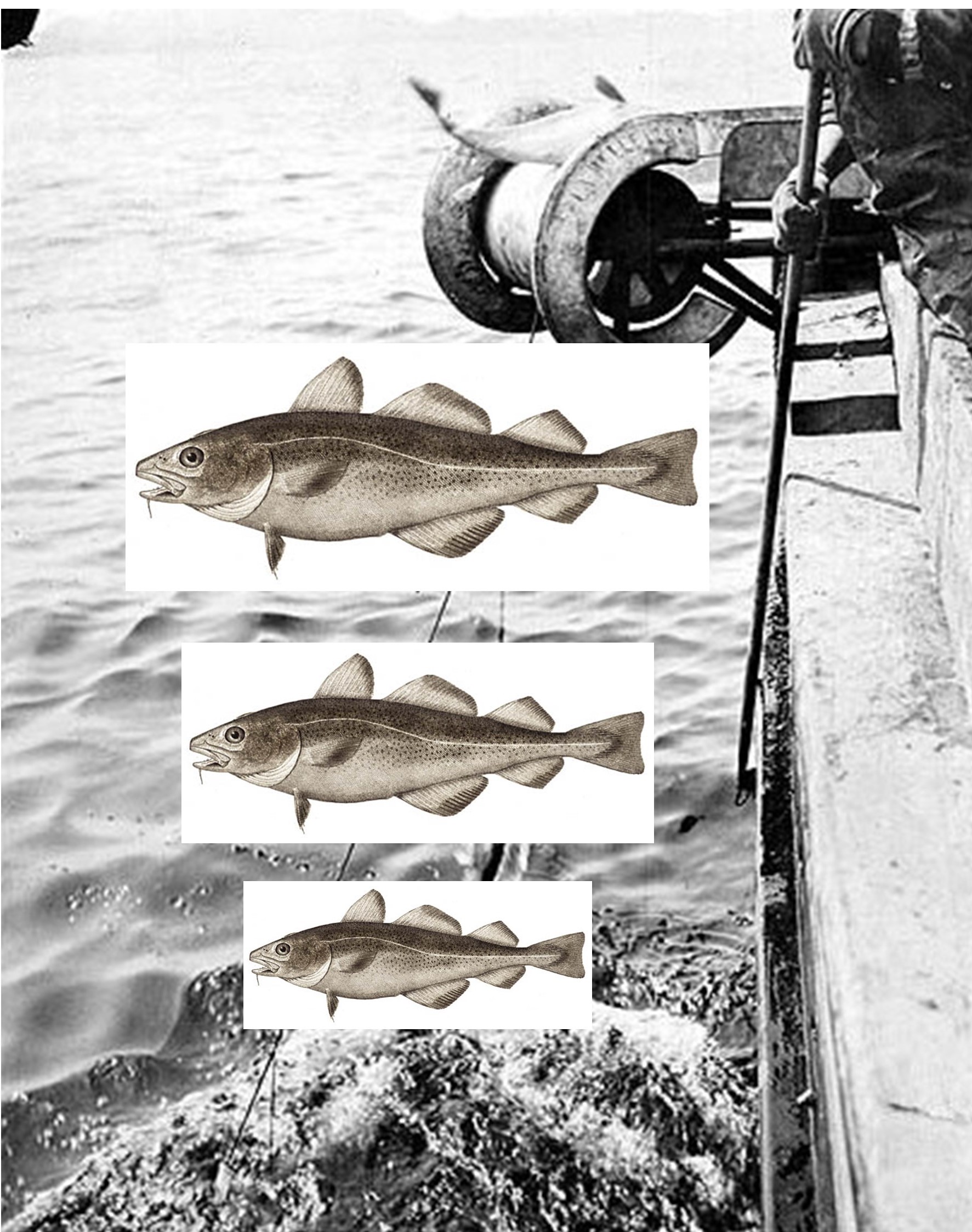Journal source: Fidler, R. Y., J. Carroll, K. W. Rynerson, D. F. Matthews, R. G. Turingan. 2018. Coral reef fishes exhibit beneficial phenotypes inside marine protected areas. PLoS ONE 13:e0193426. https://doi.org/10.1371/journal.pone.0193426
Introduction
A tale of shrinking fish
Could you imagine an ocean where the once large bodied fish, such as Bigeye tuna and Atlantic cod, were replaced by miniature versions of themselves? While scientists have already established that commercial fishing is responsible for population declines of many species, growing evidence suggests that fishing may be leading fished populations to change in important ways. Populations of several fish species subjected to commercial fishing exploits are experiencing shifts in important phenotypes, which are sets of observable characteristics of an individual, such as body size, growth rate, and fecundity (reproductive capacity).

Little fish, but a much bigger picture
The nature of human fishing efforts preferentially removes the oldest and largest individuals from any given population. Intensive, size-selective mortality caused by fishing generates a directional selection pressure that favors individuals with smaller body sizes. One might ask, “So what, this fish species is getting smaller, why do we care?”
Changes in body size can have major effects on fish populations. For many organisms, larger body size confers substantial benefits to populations; for example, larger fish tend to produce larger numbers of viable offspring compared to smaller individuals. Changes in body size frequencies can have serious ramifications on natural populations of fish species, like haddock, that end up in the seafood section of your local grocery store.
There is a suite of population-wide consequences that can result from this shift to smaller individuals-declines in population growth rate and lowered reproductive capability. For instance, reduced size and age at maturation (ready to reproduce), caused by overfishing, was responsible for the near disappearance of Atlantic cod populations in southern Labrador and eastern Newfoundland, Canada in the late 1980s. The Newfoundland Grand Banks were once the most productive fishing grounds for cod, but the local fisheries were quickly squashed by foreign commercial trawlers that decimated the once grandiose cod population. Despite a fishing moratorium enacted in 1992, Atlantic cod populations have struggled to recover to their pre-fishing population characteristics.
How can we restore natural fish population phenotypes?
A common component of fishery management efforts is no-take marine reserves or marine protected areas (MPAs). These are designated zones in which fishing and other exploitative activities are prohibited entirely or limited to certain seasons or size classes. Nearly 10,000 MPAs have been established worldwide, covering 3.9% of the total ocean surface (14.2 km^2). MPAs greatly reduce size-selective fishing efforts, which ideally should eliminate fishing-induced population changes within their borders. Controlled laboratory experiments have shown that some fish populations are able to restore historical body-size distributions in a few generations after size-selective harvests have ceased. These laboratory-based results suggest that MPAs may reverse the negative fishing-induced shifts in fish populations, because in the absence of size-selective harvesting, ecological gradients select for larger body size and size-at-maturity. However, it remains to be determined if the results seen in those laboratory trials actually happen in wild fisheries.
The study
The present study compared important phenotypes of three fish species populations in unprotected fished reefs and strictly enforced no-take MPAs in the Philippines.

The researchers measured body size, growth rate, length, and age at 50% maturity of three fish species directly targeted by fishers for food in the region: Acanthurus nigrofuscus (brown surgeonfish), Ctenochaetus striatus (lined bristletooth), and Parupeneus multifasciatus (manybar goatfish).

After collecting the specimens from each MPA and adjacent reefs, the researchers measured each fish for standard length, assessed reproductive maturity, and determined age by dissecting otoliths, which are small bones in the fish inner ear that store information on yearly growth, and can be read in a manner similar to tree rings.
Results
The authors found that body length for all of the fish species was higher inside MPAs compared to fished reefs, an observation supporting previous claims that MPAs can promote positive shifts in the frequency of large-bodied fish within their borders. However, the researchers found that fish maturation schedules were inconsistent across the three MPAs. At one MPA, the lined bristletooth population had a lower age at 50% maturity compared to the fished reefs.
Age of the MPAs seemed to play a role in the ability of fish populations to demonstrate recovery to larger body sizes and maturation at later ages. The researchers found significantly larger body lengths of middle aged fish in the two oldest MPAs. This finding suggests that the beneficial effects of MPAs on fish phenotypes may take several generations to appear.
What about the size of the MPAs? Interestingly, size did not seem to be a significant factor influencing phenotypic variation between sites. It is possible that both age and size of MPAs play synergistic roles in promoting beneficial phenotypic shifts in exploited fish populations.
Even though MPAs are established to reduce exploitative activities within their boundaries, fish populations do not necessarily stay within those imaginary boundaries. Many fish species feed and spawn away from sheltered MPAs, spanning hundreds of meters, sometimes kilometers. This innate behavior of some fish species to roam may make it hard to detect differences in their phenotypes between MPAs and fished reefs. The observed phenotypic changes inside MPAs are likely the result of the removal of fishing mortality. It is possible that extended periods of protection may be necessary for populations to reach high enough densities that promote positive shifts in body size and fecundity.
Why this study matters
This study shows that MPAs are beneficial for exploited fish populations. Because the authors found that important fish phenotypes within the MPAs generally approached the expected characteristics of unexploited populations, MPAs may be critical refuges for fish species to recover from overfishing. Maybe MPAs, if they are protected for decades to come, can turn back the clock for species such as Atlantic cod and tuna. Of course, the relative impact of MPAs will depend on the life histories of the fish species; migratory fish may not stay safe for long, but fish with small territories may be able to rebound. In addition, several reef fish species use multiple habitats throughout their lifetime, making it important for MPAs to cover all the adjacent ecosystems such as mangroves and seagrass beds. This study showcased just a handful of MPAs from one study site- we definitely need more researchers to study the effects of MPAs on fish populations around the globe. Hopefully, with more research and more evidence that MPAs benefit hurting fish populations, scientists can inform better management of our precious ocean resources.
Kate received her Ph.D. in Aquatic Ecology from the University of Notre Dame and she holds a Masters in Environmental Science & Biology from SUNY Brockport. She currently teaches at a small college in Indiana and is starting out her neophyte research career in aquatic community monitoring. Outside of lab and fieldwork, she enjoys running and kickboxing.

